Mastering the use of Bollinger Bands for day trading involves understanding the functions of the three key lines. The middle band acts as a trend gauge, while the upper and lower bands serve as dynamic support/resistance levels, adapting to market volatility. They are essential for pinpointing overbought/oversold conditions, pivotal in crafting effective day trading strategies. Understanding how these bands adapt to market changes is vital for successful trading decisions. By mastering the intricacies of Bollinger Bands, traders gain a valuable tool for maneuvering the complexities of day trading. Explore further to enhance your day trading skills and refine your strategies for excellent results.
Understanding Bollinger Bands Basics
In day trading, a fundamental aspect to comprehend is the basic structure and functionality of Bollinger Bands. These bands consist of three lines: the middle band, which is a 20-day Simple Moving Average (SMA), and the upper and lower Bollinger bands, which are calculated by adding and subtracting two times the standard deviation of price from the SMA. The middle band serves as a trend indicator, while the upper and lower bands act as dynamic levels of support and resistance. One key feature of Bollinger Bands is their ability to adapt to market volatility; the bands widen during periods of high volatility and contract during calmer market conditions.
For day traders, Bollinger Bands are essential tools for identifying potential overbought or oversold conditions in the market. When prices touch the upper band, it may indicate an overbought situation, suggesting a potential reversal or correction. Conversely, when prices touch the lower band, it may signal an oversold condition, hinting at a possible price increase. Understanding these basics is vital for utilizing Bollinger Bands effectively in day trading strategies.
Calculating Bollinger Bands
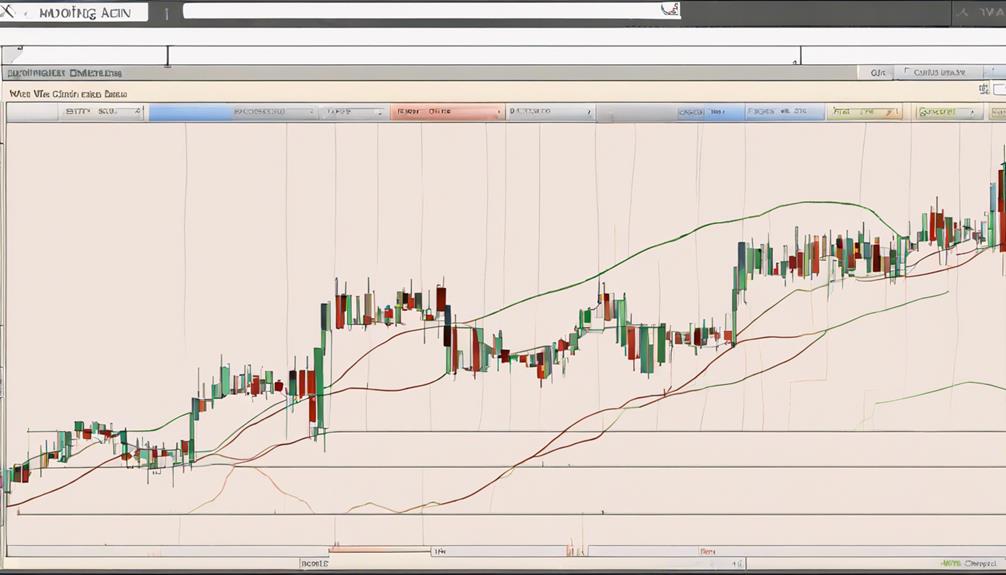
The calculation of Bollinger Bands involves two critical components:
- Band Width Calculation determines the width of the bands based on market volatility.
- Moving Average Computation establishes the central reference point for the bands.
These calculations are fundamental for traders to gauge potential price movements and make informed decisions in day trading scenarios.
Band Width Calculation
An essential step in utilizing Bollinger Bands for day trading involves calculating the band width, which serves as a key indicator of market volatility and potential price movements.
- Band width is calculated by taking the difference between the upper and lower Bollinger Bands.
- It represents the volatility in the market and provides insights into potential price movements.
- The wider the band width, the higher the volatility, while narrower band widths indicate lower volatility.
- Traders use band width to assess market conditions and make informed trading decisions.
Calculating band width can help traders anticipate breakouts, reversals, and trend continuation based on volatility levels. This calculation is vital for understanding market dynamics and adjusting trading strategies accordingly.
Moving Average Computation
Utilizing a 20-day Simple Moving Average (SMA) forms the foundation for calculating Bollinger Bands in day trading strategies. The upper band is determined by adding 2 times the standard deviation to the SMA, while the lower band is calculated by subtracting 2 times the standard deviation from the SMA.
This methodology aids traders in understanding the range within which prices typically fluctuate. Bollinger Bands provide valuable insights into potential price breakouts, reversals, and trend strength.
The middle band, based on the SMA, acts as a trend indicator, whereas the upper and lower bands function as dynamic support and resistance levels. Mastering the computation of Bollinger Bands is essential for traders seeking to make informed decisions based on these technical indicators.
Interpreting Bollinger Bands for Trading
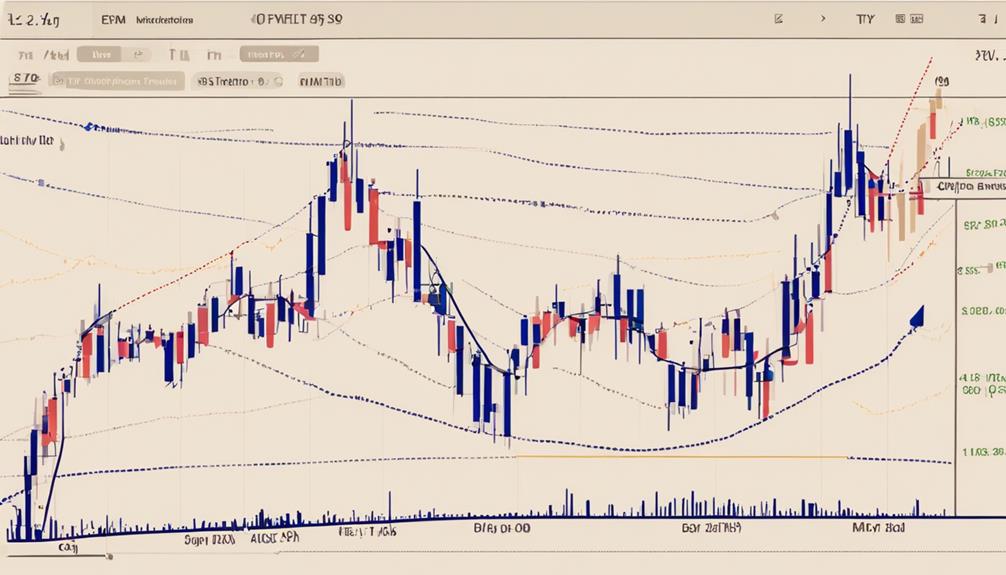
Interpreting Bollinger Bands involves analyzing how market volatility affects the width of the bands, providing insights into potential price movements. Bollinger Bands adjust dynamically based on market volatility, with wider bands indicating higher volatility levels and narrow bands suggesting lower volatility periods.
Touching the upper band may signal overbought conditions, implying that the asset price could be overextended and due for a potential reversal. Conversely, falling below the lower band may indicate oversold conditions, suggesting that the asset price might be undervalued and poised for a rebound.
The middle band serves as a trend indicator, while the upper and lower bands act as dynamic levels of support and resistance. Understanding the expansion and contraction of Bollinger Bands can help traders accurately identify potential trend shifts and pinpoint overbought or oversold conditions in the market.
Effective Bollinger Bands Strategies
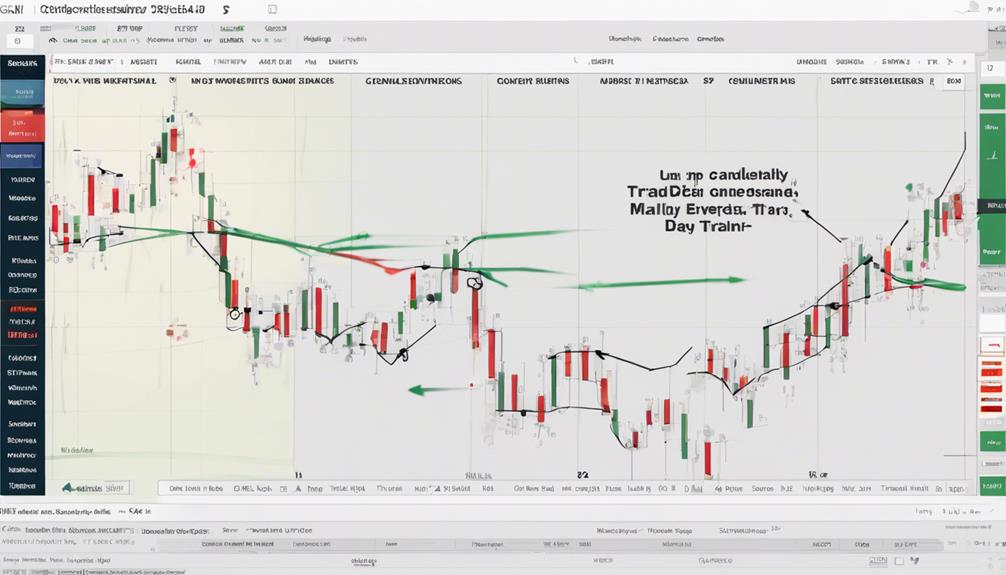
When considering effective Bollinger Bands strategies for day trading, a thorough understanding of market dynamics and volatility patterns is essential for successful implementation. Bollinger Bands Squeeze Breakout trading signals are particularly valuable during low volatility periods, as they can indicate potential price breakouts.
To enhance buy/sell signals, traders can combine Bollinger Bands with indicators like the Bollinger Bands B Indicator and RSI Divergence. It is vital to implement prudent risk management techniques when utilizing Bollinger Bands strategies to mitigate potential losses.
The Bollinger Squeeze is a useful tool for identifying low volatility conditions, while the Bollinger Breakout signal can confirm trend continuation, aiding in effective day trading.
Advanced techniques, such as incorporating the Bollinger Bands B Indicator and RSI Divergence, can further refine entry and exit points, improving the overall success rate of day trading strategies.
Advanced Techniques With Bollinger Bands
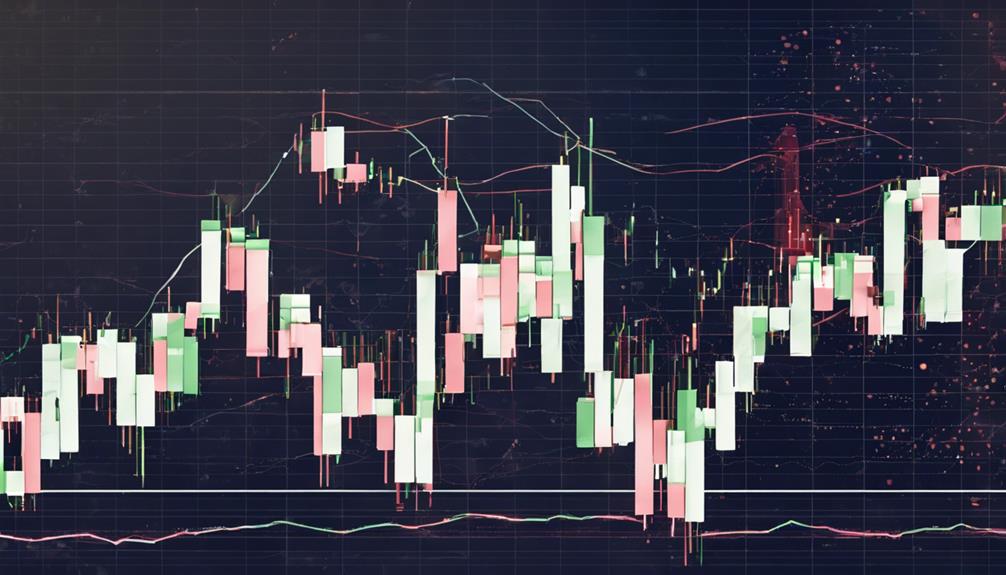
An effective incorporation of advanced techniques with Bollinger Bands can greatly enhance the precision and success of day trading strategies. When utilizing Bollinger Bands for day trading, traders can explore various advanced techniques to improve their decision-making process and overall trading outcomes.
Some of these techniques include:
- RSI Divergence: Combining Bollinger Bands with RSI Divergence allows traders to identify potential trend reversals more effectively by looking for discrepancies between price movements and the RSI indicator.
- Chart Patterns: Integrating chart patterns alongside Bollinger Bands can provide additional validation and confirmation signals, enhancing the reliability of trading setups.
- Risk Management: Implementing proper risk management practices, such as setting stop-loss orders based on Bollinger Bands signals, is essential to protect capital and minimize losses in day trading.
- Breakout Strategy: Utilizing the Bollinger Bands Breakout strategy can help traders capture strong trends early on, leading to profitable trading opportunities and improved performance.
Best Bollinger Band Setting for Day Trading
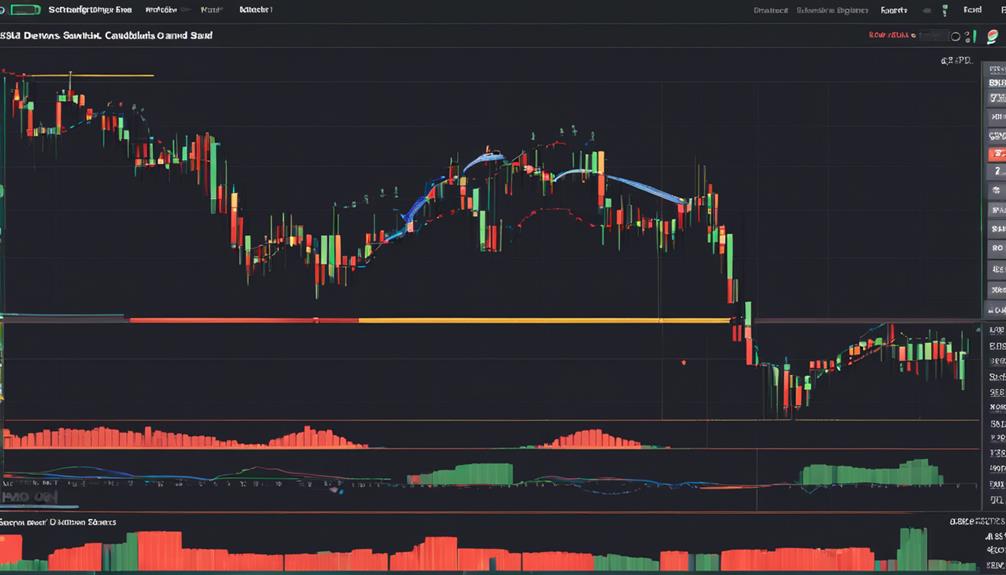
Incorporating the ideal Bollinger Bands setting is crucial to enhancing day trading strategies and maximizing trading outcomes. For day trading, the recommended Bollinger Bands setting typically involves a 20-period Simple Moving Average (SMA) with 2 standard deviations. These default settings are favored by day traders for their effectiveness in capturing short-term price movements. However, adjusting the Bollinger Bands settings can offer flexibility to fine-tune strategies based on the desired timeframe and prevailing market conditions. Intraday trading may require traders to experiment with shorter periods or different standard deviations to adapt to the faster pace of price action. The optimal Bollinger Bands setting for day trading should align with the trader's risk tolerance, trading style, and the specific assets being traded.
| Parameter | Value |
|---|---|
| Period | 20 |
| Moving Average Type | Simple |
| Standard Deviations | 2 |
Bollinger Band Length for Day Trading
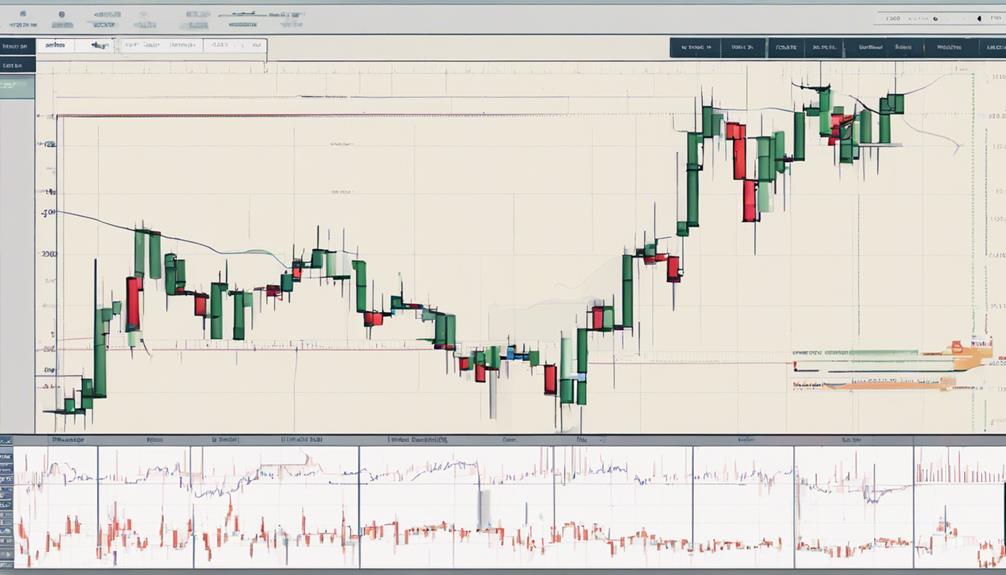
To optimize day trading strategies utilizing Bollinger Bands effectively, selecting an appropriate length for the bands is a vital consideration. Day traders often find the 20-day Simple Moving Average (SMA) to be a valuable choice for the middle band in Bollinger Bands. This length setting, combined with 2 standard deviations for the upper and lower bands, helps capture short-term price movements and volatility essential for day trading strategies. Adjusting the length of the SMA allows traders to tailor their approach, with shorter periods providing more sensitive signals. The 20-day length is widely favored among day traders for its ability to strike a balance between identifying trends and filtering out intraday price noise effectively.
- Popular choice: 20-day SMA for middle band
- Sensitivity: Use of 2 standard deviations
- Customization: Adjusting SMA length
- Balancing act: Capturing trends while filtering out noise
Mastering Bollinger Bands

Mastering Bollinger Bands involves delving into band width interpretation and volatility signal analysis. Understanding how the band width changes in response to market conditions can provide insights into potential price movements.
Analyzing volatility signals can help traders identify ideal entry and exit points based on Bollinger Bands' dynamic nature.
Band Width Interpretation
Derived from Bollinger Bands, band width serves as an important metric that reflects the distance between the upper and lower bands, providing valuable insights into market volatility levels. Traders utilize band width to gauge the level of volatility in the market, with wider bands indicating higher volatility and narrower bands suggesting lower volatility. By interpreting band width, traders can assess potential price movements and current market conditions, aiding in making well-informed trading decisions.
Understanding fluctuations in band width over time can signal upcoming trends, breakouts, or reversals in price action, allowing traders to capitalize on shifts in market sentiment and identify trading opportunities effectively.
- Band width reflects the distance between upper and lower bands
- Wider bands suggest higher volatility; narrower bands indicate lower volatility
- Helps traders assess price movements and market conditions
- Signals upcoming trends, breakouts, or reversals
Volatility Signal Analysis
Exploring the intricacies of volatility signal analysis within the domain of Bollinger Bands provides traders with a thorough understanding of market dynamics and potential price movements. Bollinger Bands expand and contract based on market volatility, offering insights into potential price shifts. Touching the upper band may signal overbought conditions, suggesting a possible reversal or correction in the market. Conversely, falling below the lower band could indicate oversold conditions, implying a potential buying opportunity. By utilizing Bollinger Bands for volatility signal analysis, traders can effectively assess market conditions, anticipate trend shifts, and make informed decisions. The table below summarizes key points related to volatility signal analysis using Bollinger Bands:
| Aspect | Description |
|---|---|
| Bollinger Bands | Expand or contract based on market volatility |
| Overbought Conditions | Touching upper band may signal overbought |
| Oversold Conditions | Falling below lower band could indicate oversold |
| Potential Price Movements | Offer insights into possible price shifts |
Bollinger Bands for Intraday Trading
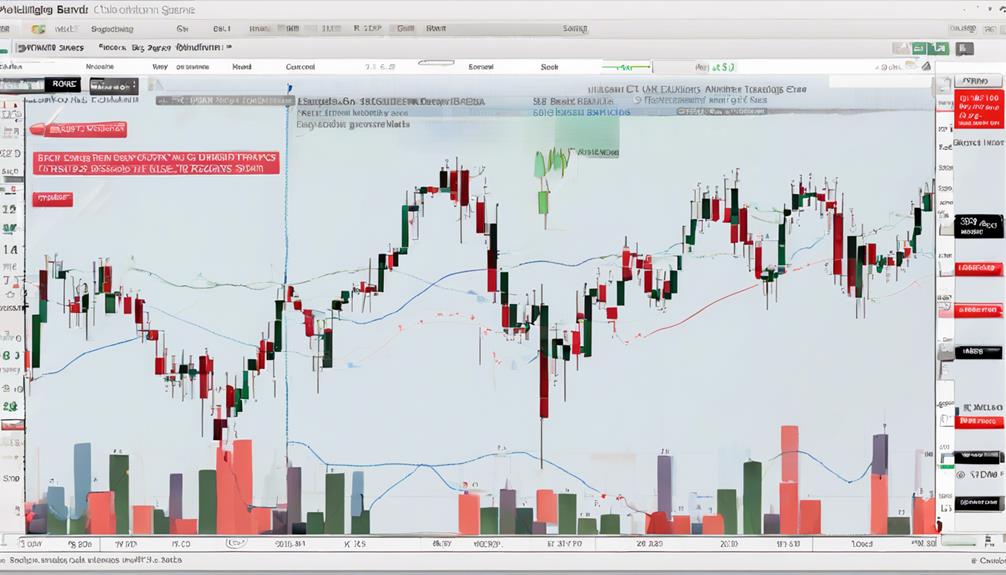
When engaging in intraday trading, utilizing Bollinger Bands can assist traders in identifying short-term price volatility and potential trend shifts. Traders can adjust the settings of Bollinger Bands to cater to different timeframes, enabling them to adapt to the fast pace of intraday trading.
The dynamic nature of Bollinger Bands allows for quick decision-making, providing valuable insights into market conditions for day traders. Additionally, incorporating the Bollinger Bands B Indicator in intraday trading strategies can enhance the precision of identifying entry and exit points, essential for maximizing profits and managing risks effectively.
- Bollinger Bands help identify short-term price volatility and potential trend shifts.
- Traders can adjust Bollinger Bands settings for different timeframes.
- Bollinger Bands' dynamic nature enables quick decision-making in day trading.
- Utilizing Bollinger Bands B Indicator enhances precision in entry and exit points.
Bollinger Bands Best Settings Strategy
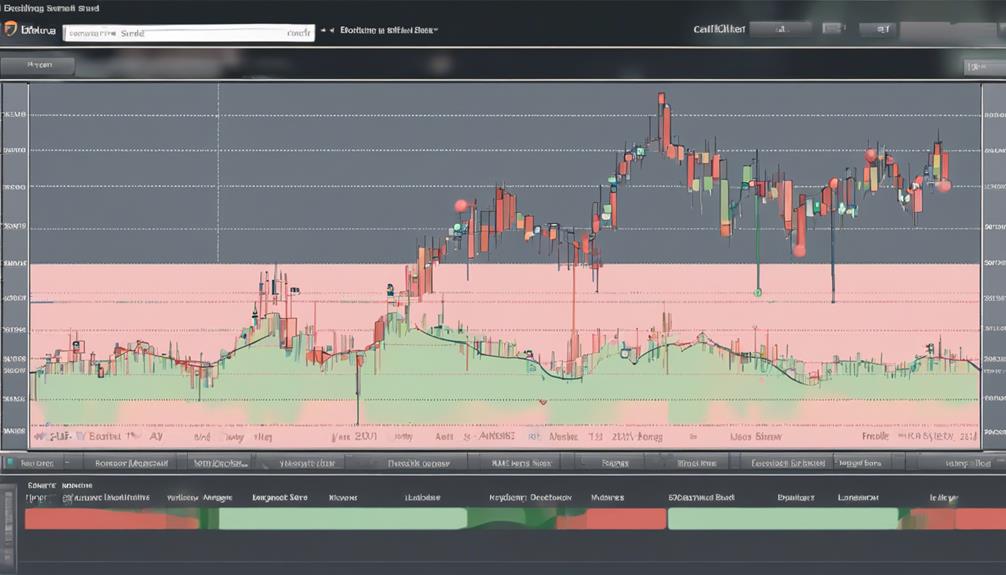
When refining the Bollinger Bands settings for day trading, traders aim to find the best band parameters that offer effective entry signals.
Adjusting the period and standard deviation values can impact the sensitivity and accuracy of the bands, influencing the trading strategy's performance.
Optimal Band Parameters
For efficient utilization of Bollinger Bands in day trading, traders often consider using a 20-period Simple Moving Average (SMA) with 2 standard deviations as the recommended parameters. John Bollinger suggests a 9-12 period setting with 2 standard deviations for more sensitive bands.
Traders have the flexibility to adjust the default settings to suit different trading styles and timeframes, whether they are scalping or swing trading. This adaptability allows traders to fine-tune Bollinger Bands for specific market conditions and asset volatility.
Experimenting with various settings is essential in optimizing Bollinger Bands for day trading strategies, leading to enhanced trading outcomes.
Effective Entry Signals
Efficient utilization of Bollinger Bands in day trading requires a keen focus on generating effective entry signals by employing the best settings strategy. The ideal settings typically involve a 20-day Simple Moving Average (SMA) with 2 standard deviations for the upper and lower bands.
Effective entry signals are often triggered when the price touches or breaches the upper or lower bands of the Bollinger Bands. To enhance signal accuracy, traders can combine Bollinger Bands with indicators like the RSI.
It is common practice for traders to seek out price rejections at the bands or trend reversals following a consolidation period to identify potential entry points. Understanding these dynamics and experimenting with different settings can aid traders in pinpointing optimal entry opportunities for their day trading strategies.
Double Bollinger Band Strategy
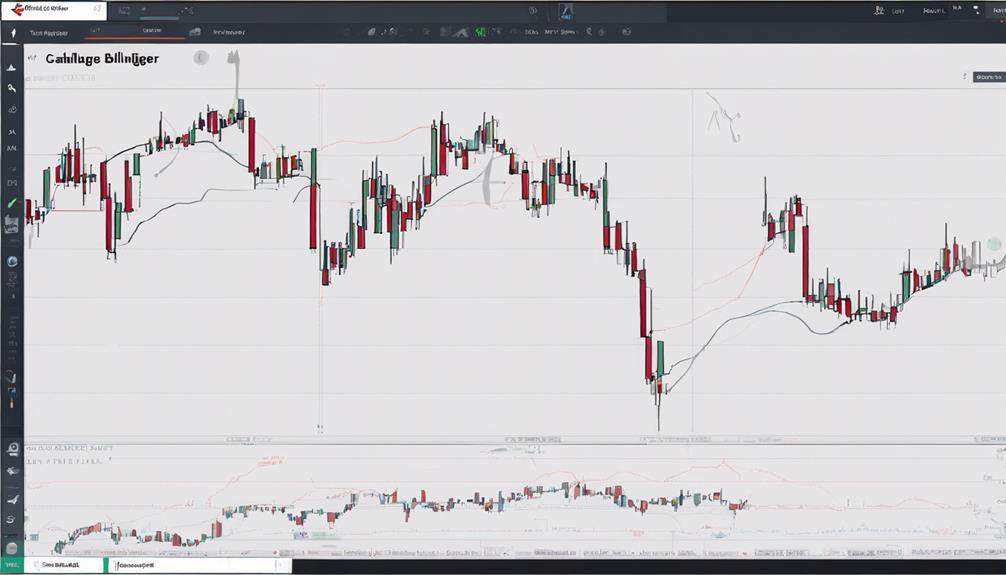
The Double Bollinger Band strategy, a sophisticated technical analysis approach, involves utilizing two distinct sets of Bollinger Bands to pinpoint potential entry and exit points in day trading scenarios. This strategy incorporates the following key elements:
- The inner Bollinger Bands are set at 1 standard deviation from the 20-day SMA, while the outer bands are set at 2 standard deviations.
- Traders analyze price action within the inner bands to identify a strong trend or monitor for potential breakouts beyond the outer bands signaling a reversal.
- The strategy aims to capture strong trending moves while filtering out market noise and false signals.
- By employing two sets of Bollinger Bands, traders gain a clearer view of price volatility and trend strength, enabling more precise trading decisions.
This approach enhances the trader's ability to interpret market dynamics and make informed choices based on the strength and direction of trends, ultimately improving the overall day trading performance.
Buying Low and Selling High
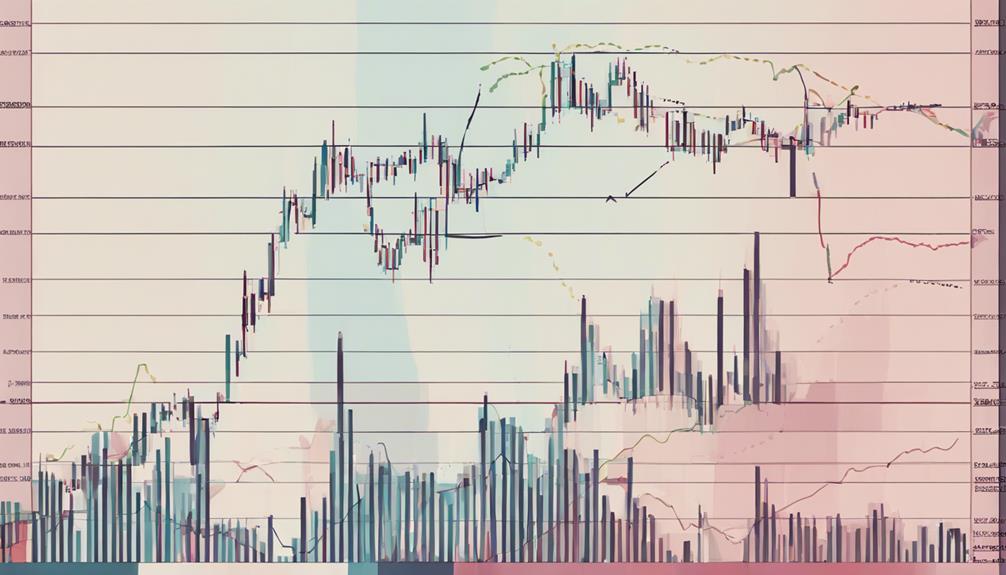
Strategically buying assets at lower Bollinger Bands and selling them at higher bands is a tactical approach employed by traders to capitalize on potential undervaluation and overvaluation signals respectively.
Buying low involves purchasing an asset when its price is at a lower band of the Bollinger Bands, indicating potential undervaluation. Conversely, selling high entails selling an asset when its price reaches the upper band of the Bollinger Bands, suggesting overvaluation.
Traders aim to capitalize on price mean reversion by buying at lower bands and selling at upper bands, aligning with the concept of buying assets at a discount and selling them at a premium.
Successfully implementing the buying low and selling high strategy requires keen observation of price movements relative to the Bollinger Bands' upper and lower boundaries. By capitalizing on these signals of undervaluation and overvaluation, traders can enhance their profitability and make informed decisions based on the principles of Bollinger Bands.
Bollinger Bands Bounce Trading Strategy Rules
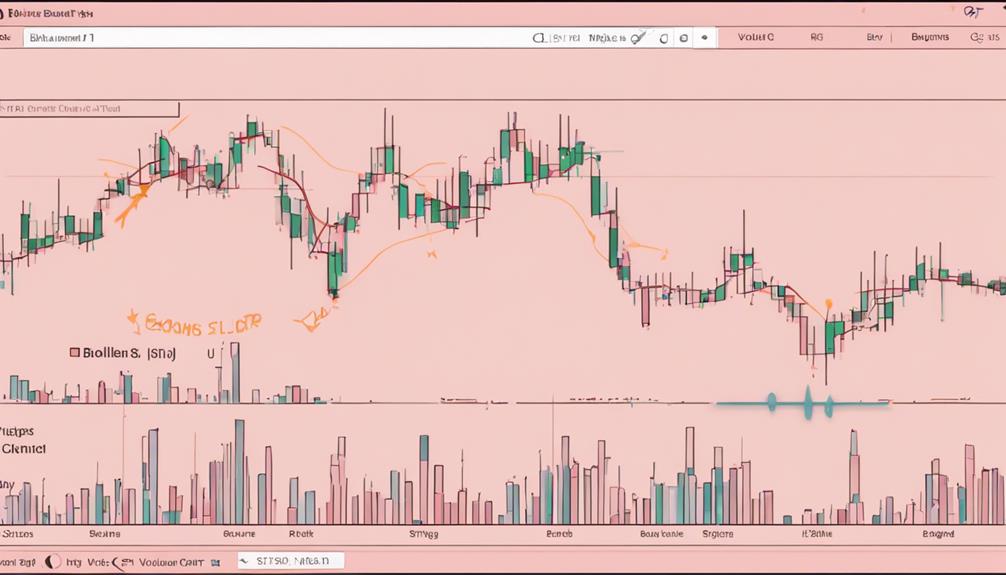
The Bollinger Bands Bounce Trading Strategy Rules encompass fundamental aspects such as:
- Understanding the strategy basics
- Setting precise entry points
- Effectively managing risk
By grasping these rules, traders can strategically capitalize on price bounces within the bands, optimizing their trading decisions.
Implementing these guidelines can enhance the accuracy and efficiency of the Bollinger Bands Bounce Trading Strategy, leading to more successful trading outcomes.
Bounce Strategy Basics
When implementing the Bollinger Bands Bounce Trading Strategy, the key principle that guides the decision to buy or sell based on price interactions with the bands is capitalizing on price movements that revert back to the middle band after touching the outer bands. To effectively utilize this strategy, traders can consider the following:
- Utilizing the RSI indicator to confirm bounce trading signals.
- Setting appropriate stop-loss and take profit targets.
- Applying the strategy in various market conditions such as trend continuation, reversals, range trading, and breakouts.
- Buying when the price touches the lower band and selling when it touches the upper band.
Setting Entry Points
To effectively execute the Bollinger Bands Bounce Trading Strategy, identifying ideal entry points involves observing price bounces off the upper or lower bands. These bounces indicate potential reversal or continuation points in the price movements. Additionally, incorporating the Relative Strength Index (RSI) as a confirming indicator can enhance the accuracy of entry signals derived from the Bollinger Bands.
When setting entry points, traders should establish clear stop loss and take profit levels to manage risk effectively. By utilizing this strategy, traders can capitalize on price movements bouncing off the bands in various market conditions such as trend continuation, trend reversal, range-bound markets, and breakout scenarios.
Mastering the skill of identifying entry points is essential for successful bounce trading using Bollinger Bands.
Managing Risk Effectively
Upon engaging in the Bollinger Bands Bounce Trading Strategy, a primary focus lies in implementing stringent risk management protocols to safeguard trading positions and optimize profitability.
- Utilize RSI as a supplementary indicator to validate bounce trading signals.
- Establish precise stop-loss and take-profit targets based on price action and band movements.
- Apply the strategy for trend continuation, reversals, range trading, and breakout scenarios.
- Capitalize on price reverting within the bands for profitable trades with controlled risk.
Bollinger Bands Bounce Trading Strategy Benefits
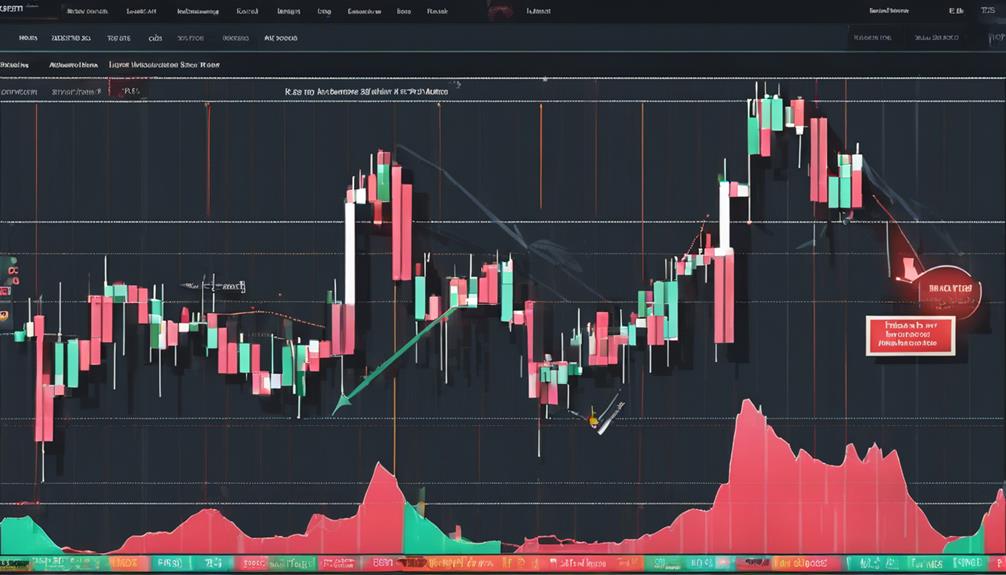
Utilizing the Bollinger Bands Bounce Trading Strategy provides day traders with a systematic approach to identifying and capitalizing on potential price reversals in the market. By leveraging the bands as dynamic support and resistance levels, traders can pinpoint areas where prices are likely to bounce back, offering entry points for profitable trades.
Combining Bollinger Bands with indicators like the RSI enhances the strategy's effectiveness by providing confirmation signals for these bounce opportunities. Properly setting stop-loss and take-profit targets is essential in managing risk and maximizing returns when implementing this strategy.
Day traders benefit from the versatility of this approach, as it can be applied across various market conditions, including trend continuation, reversal, range-bound markets, and breakouts. Following the rules and best practices of the Bollinger Bands Bounce Trading Strategy enables traders to capitalize on price bounces within the bands, presenting lucrative day trading opportunities.
What Are Some Advanced Techniques for Using Bollinger Bands in Day Trading?
When it comes to bollinger bands trading strategies, day traders can benefit from advanced techniques such as using multiple time frames, combining with other indicators, and utilizing volatility breakout strategies. These methods can help traders make more informed decisions and increase the effectiveness of their bollinger bands trading strategies.
How Can Bollinger Bands Help in Mastering Day Trading?
Bollinger Bands are a crucial tool for mastering day trading. By analyzing price volatility and identifying potential reversal points, the top trading applications Bollinger Bands can provide valuable insights for traders. Understanding the signals generated by Bollinger Bands can greatly enhance decision-making and improve trading outcomes.
Bollinger Bands Bounce Trading Strategy Risks
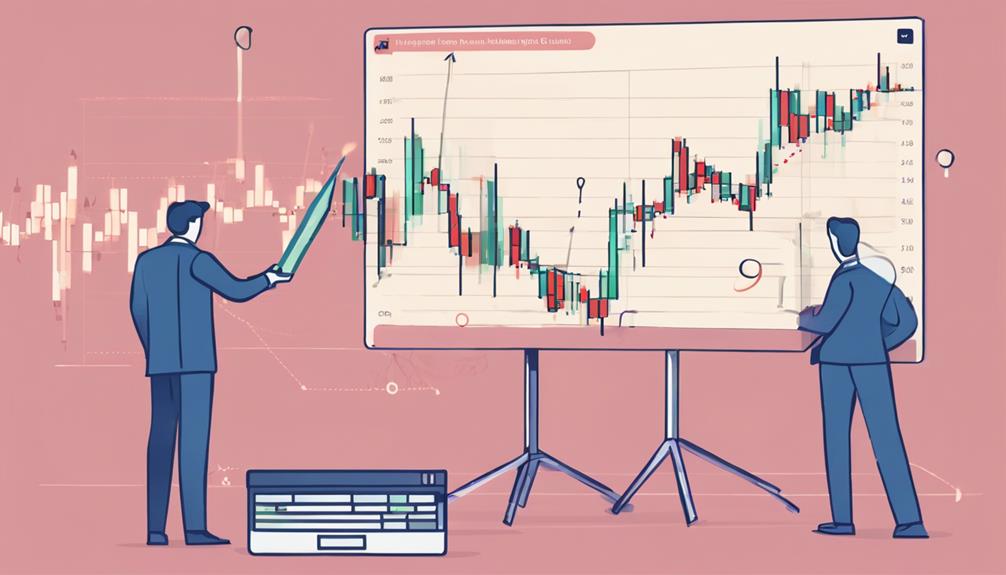
Mastering the Bollinger Bands Bounce trading strategy entails careful consideration of the inherent risks involved in exploiting price reversals within the market. Traders utilizing this strategy should be aware of the following risks:
- False Signals: The strategy carries risks of false signals, especially during low volatility periods, which can lead to entering trades based on misleading information.
- Market Reversals: Sudden market reversals can occur, invalidating Bollinger Bands bounce signals and causing unexpected losses if not anticipated and managed effectively.
- False Breakouts: False breakouts beyond the bands are possible, resulting in traders being caught on the wrong side of the trade and experiencing losses if risk mitigation strategies are not in place.
- Volatility Levels: Market conditions impacting volatility levels can substantially affect the efficacy of the Bollinger Bands Bounce strategy, requiring traders to adapt to changing market dynamics promptly.
To navigate these risks successfully, traders must prioritize robust risk management practices, such as setting stop-loss orders and carefully managing position sizes to safeguard against potential downsides associated with the Bollinger Bands Bounce trading strategy.
Can Bollinger Bands Be Used for Day Trading?
Yes, mastering Bollinger Bands for traders can be incredibly useful for day trading. By understanding the different signals that the bands can provide, traders can effectively analyze market volatility and make more informed decisions about when to enter and exit trades.
Frequently Asked Questions
How to Use Bollinger Bands for Day Trading?
Bollinger Bands can assist day traders by pinpointing entry points, setting stop losses, and managing risks effectively. They help identify trends, analyze volatility, and interpret price action for best trade setups.
How Long Should Bollinger Band Be for Day Trading?
The ideal timeframe for Bollinger Bands in day trading is commonly set at 20 days. This setting helps traders capture short-term price trends efficiently.
Setting stop losses, identifying entry points, exit signals, and avoiding false signals are vital aspects when using Bollinger Bands.
Additionally, proper risk management strategies should be employed to mitigate potential losses and maximize profits in day trading activities.
What Is the Best Strategy for Bollinger Bands Trading?
In Bollinger Bands trading, the most effective strategy involves combining entry signals, exit strategies, risk management, trend identification, volatility measurement, trade setups, and price targets for best results.
By using Bollinger Bands in conjunction with other indicators, traders can identify potential buy/sell signals and confirm trend directions.
Implementing a thorough approach that considers various factors can enhance the effectiveness of Bollinger Bands in day trading strategies.
Is Bollinger Bands a Good Indicator for Intraday Trading?
Bollinger Bands are a valuable indicator for intraday trading due to their effectiveness in analyzing intraday volatility, identifying price patterns, and facilitating real-time market analysis.
By offering insights into market timing, price action, and risk management, Bollinger Bands help traders make informed decisions throughout the trading day.
Their adaptability to short-term price fluctuations and ability to track overbought and oversold conditions make them a reliable tool for intraday trading strategies.
Conclusion
To sum up, mastering the use of Bollinger Bands for day trading requires a solid understanding of the basics, effective strategies, and advanced techniques.
While there are risks involved in trading, implementing a disciplined approach can help mitigate potential losses.
By carefully interpreting Bollinger Bands and following proven trading strategies, traders can increase their chances of success in the volatile world of day trading.


